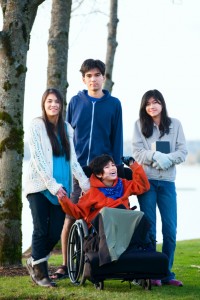Bringing a child into the world can complete a growing family and give our lives a deeper meaning. There is nothing more important than safe prenatal care and a safe delivery to ensure your baby is able to enjoy normal, healthy development.
Unfortunately, improper medical care before, during or after your child’s birth can cause devastating brain injuries like spastic cerebral palsy, which impairs speech and development in children, and may affect them for the rest of their life. This is crushing for families who have placed their trust in the doctors and other professionals responsible for the wellbeing of their child.
You need an experienced attorney to help you determine if your child’s birth injury could have been prevented with proper medical care. The attorneys at The Oshman Firm have stood beside New Yorkers for more than 35 years, winning millions of dollars in compensation for physical and emotional damages from those responsible for birth injuries.
What is Spastic Cerebral Palsy?
 Spastic cerebral palsy is a condition in which brain damage disrupts regular muscle function. It is the most common form of cerebral palsy, and often causes the muscles of those affected to stiffen up or spasm in sudden, jerky movements.
Spastic cerebral palsy is a condition in which brain damage disrupts regular muscle function. It is the most common form of cerebral palsy, and often causes the muscles of those affected to stiffen up or spasm in sudden, jerky movements.
In normally functioning brains, groups of muscles turn on and off depending on signals sent from the brain. In children with spastic cerebral palsy, these signals are sent incorrectly. Multiple or wrong muscle groups may activate at once, making actions that are basic and routine for the rest of us difficult or impossible.
What Causes Spasticity?
Spasticity refers to an increase in the amount of tension needed for your muscles to maintain posture or sustain movement against gravity. Normally, tension is controlled by your brain and spinal cord, which coordinate with nerves to increase or reduce the tension used to control muscle movement.
Trauma to the central nervous system of a child’s brain before, during or after birth may result in a disruption of the communication process between the two organs, and consequently the increased muscle tension that causes spasticity.
Spastic Cerebral Palsy Symptoms
Symptoms of spastic cerebral palsy normally appear before a child is two, and may be visible as early as three months into the child’s life.
Physical symptoms may be more pronounced in the arms or legs, or may affect both equally. A child with spastic cerebral palsy can have normal intelligence, but learning and developmental issues are common.
Common ways for spastic cerebral palsy to present in a child are:
- Involuntary movements in the form of isolated or continuous spastic muscle contractions
- Delayed development of motor functions, which may affect eating, drinking, writing, using objects and getting dressed
- Overactive reflexes
- Difficulty standing or sitting upright
- Difficulty walking and running
- Bone and joint deformities not present at birth
- Unusual or abnormal posture
- Decreased intelligence and learning disabilities
- Speech difficulty
- Seizures
- Chronic pain
Types of Spastic Cerebral Palsy

Spastic cerebral palsy is categorized into five forms, depending on which parts of the child’s body are affected by the illness.
Spastic Monoplegia: This form of spastic cerebral palsy affects only one limb on the child. This limb is typically one of the arms, and is commonly a non-painful condition that may resolve itself through time.
Spastic Diplegia: This form of spastic cerebral palsy is characterized by either both legs or both arms being affected, though the majority of cases affect the legs. Due to a related weakness in eye muscles, children with diplegia may suffer from strabismus – commonly known as “cross-eye.”
Spastic Triplegia:This form of spastic cerebral palsy occurs when three limbs are affected – either both arms and one leg, or both legs and one arm, with the latter typically being more common.
Spastic Hemiplegia: Hemiplegia affects an entire side of a child’s body, causing him or her to experience tremors on the afflicted half and suffer increased risk of learning disabilities, vision impairment and difficulties in controlling oral muscle movements.
Spastic Quadriplegia: When a child’s entire body is affected by spastic cerebral palsy, the illness is categorized as quadriplegia. In quadriplegic patients, symptoms may manifest as extreme seizures, severe mental disability, impairment of facial muscles and more.
How is Spasticity Assessed?
It’s important for physicians to be thorough when assessing the presence, impact and severity of spasticity. Additionally, a comprehensive evaluation will help in determining a child’s potential response to treatment.
During the assessment, a physician will determine:
- Which muscles are affected by the condition.
- The severity of spasticity in each muscle affected.
- The degree to which the child is able to control his or her muscles.
- Any secondary effects that may alter how the child performs tasks, including a reduction in range of motion.
In order to differentiate spasticity from other conditions that may result in increased muscle tension, a physician will also perform a hands-on test for limb stiffness to measure range of motion in joints and evaluate strength.
An observation of the child performing normal daily activities without assistance may also help in determining the severity of spasticity and the appropriate response to it.
What Can Change Over Time?
Spasticity has the potential to cause major changes in both body shape and function over time. These changes may include:
- Chronic pain from constant over-activity in affected muscles, and from deformities caused by persistent spastic pulling of the affected muscle
- Stiffness, deterioration or fibrosis in soft tissues such as muscles, tendons and ligaments
- Reduction in a joint’s range of movement, caused by an affected muscle failing to stretch out in response to bone growth. This condition is referred to as “contracture.”
- Bone deformities like scoliosis and hip dislocation as a result of shortened muscles pulling on the body’s skeletal structure
Spastic Cerebral Palsy Treatment
Unfortunately, the brain damage present in cases of spastic cerebral palsy cannot be reversed. However, surgical and therapeutic treatments have been developed to help increase control over affected limbs. Permanent or complete solutions are still unavailable, but treatment may allow an affected child to manage the condition and enjoy a higher quality of life.
Surgical options for spastic cerebral palsy include:
Selective Dorsal Rhizotomy: This surgery cuts nerve fibers responsible for high spastic tension in the legs, and can improve your child’s range and quality of motion.
Baclofen Infusion: Baclofen is a muscle relaxant that can reduce spasticity in a child’s limbs. During a baclofen pump procedure, surgeons will implant a hockey-puck sized pump into the abdomen. This pump slowly releases baclofen into the nervous system, relieving tension in affected muscles and reducing symptoms of spasticity for up to five years.
Tendon and Muscle Procedures: Spastic cerebral palsy can affect the growth and development of soft tissues in a child’s body. Orthopedic surgeries on tendons and muscle mass can reduce deformities caused by spastic shortening of these tissues and improve range of motion.
Other options for treating children with spastic cerebral palsy include botox injections, which weaken affected muscles for up to four months, and constraint-induced therapy (CIT), a physical therapy program designed to train the desired motions and increase quality of movement.
What Can I Do If My Child Is Diagnosed with Spastic Cerebral Palsy?
Treatment for spastic cerebral palsy is extensive, and the largely permanent nature of the condition means that treatment may be required for the duration of your child’s life. The stress and heartache of an ordeal like this can seem overwhelming, and the imposing medical costs involved with treating spastic cerebral palsy add an even more daunting burden.
You should not have to bear that burden alone. The attorneys at The Oshman Firm have represented New Yorkers for more than 35 years in cases of medical malpractice resulting in conditions like spastic cerebral palsy. We have the experience needed to discover if negligence is responsible for your child’s birth injury, and we have the resources and tenacity to secure you maximum compensation for the physical and emotional trauma your family is experiencing.
Contact our attorneys today by going online or calling (800) 400-8182. We’ll fight so you can focus on improving your child’s quality of life – and not on how to pay for it.
Frequently Asked Questions
The pain associated with spastic cerebral palsy can vary greatly depending on the form developed. Pain may be limited to the discomfort of tight muscles, or it may be severe enough to produce spasms of the legs and arms.
This also varies from person to person and is dependent on the form and severity of the condition. Refer to our sections on particular types of spastic cerebral palsy conditions and treatment for more information.
Approximately four-fifths of cerebral palsy patients will develop spasticity, and the condition is typically discovered within the first two years of a child’s life.
Non-spastic cerebral palsy causes the muscles of the affected child to be perpetually relaxed, as if they are non-existent, or to be stiff as if they are being constantly flexed. There are three main types of non-spastic cerebral palsy:
Dyskinetic cerebral palsy occurs when the child’s muscle tone fluctuates between rigidly stiff and entirely limp, with random sudden or jerky movements.
Athetoid cerebral palsy is similar to dyskinetic, with the condition that the movements may continue even into sleep, and the child may have problems eating, drinking or speaking because of problems controlling facial muscles.
Ataxic cerebral palsy is the rarest of the non-spastic conditions, and involves the entire body moving abnormally and uncontrollably.
